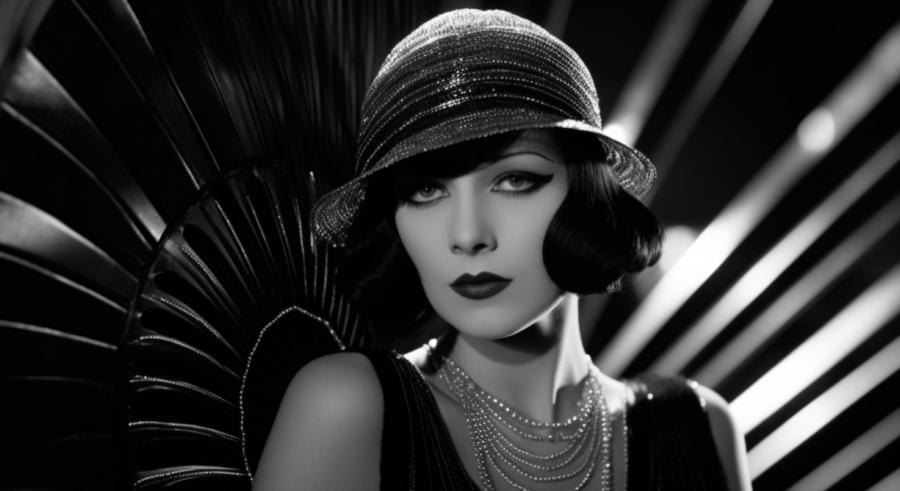Fashion in Silent Films: Black, White, and Shades of Grey

A Monochromatic World of Style
In the days of yore, when the moving pictures were still silent and lacking in color, the aesthetics of fashion were in fact, a remarkable palette of black, white, and every shade of grey in between. I know dear reader, it's a bit like trying to remember a world before iPhones, but stay with me here. As we dive into this realm of monochromatic magic, let us explore the sartorial choices in silent films that have left an indelible impression on the world of fashion.The Genesis of Cinematic Glamour
The silent film era - a time when actors and actresses had to convey their emotions and stories through exaggerated gestures, facial expressions, and body language. It was in this era that the very concept of “glamour” in film truly blossomed. Actresses such as Greta Garbo, Clara Bow, and Louise Brooks created iconic looks that transcended the screen and became entrenched in the annals of fashion history.But how were these legendary styles born out of a world devoid of color? The answer lies in the importance of contrast. Let's delve deeper into the fashionable enigma that is silent films, shall we?
Contrast: The Key to Style in Black, White, and Grey
When you're playing with a limited color palette, the key to creating visual interest and conveying a sense of style lies in the power of contrast. In silent films, this often meant the juxtaposition of black and white or the strategic use of light and shadow.One can't help but conjure up images of the effervescent Louise Brooks, her raven bob framing her porcelain features, or the sultry allure of Theda Bara, clad in her dark, dramatic costumes, against a pale, monochromatic backdrop. The striking visual contrast was not just a testament to the skill of the cinematographers, but also a clever tool employed by costume designers of the time.
Texture: Making a Statement without Color
Since the designers of the silent film era couldn't rely on color to create visual interest, they had to turn to other techniques to ensure that their creations would make an impact on-screen. One of these was the use of texture.Exquisite lace, intricate beading, and lush, embroidered fabrics dominated the wardrobe of the silent film stars. These tactile materials not only added depth and dimension to the monochromatic visuals, but they also served as a reflection of the characters" personalities and status.
Mary Pickford, the ultimate ingénue, was often seen in delicate lace dresses that highlighted her angelic visage, while the vampy Clara Bow exuded sensuality in silk and satin ensembles. But perhaps the grand dame of textures, Gloria Swanson, took it to the next level. In the 1928 film "Sadie Thompson," she wore a dress adorned with over 1,000 peacock feathers, each painstakingly sewn onto the garment by hand, just to create the illusion of movement in the black and white footage. Now that's commitment to the craft!
Accessorizing in a Monochromatic World
Ah, accessories - the proverbial icing on the cake when it comes to fashion! In the silent film era, these essential accoutrements were carefully chosen to not only complement the garments, but also to create a visual impact on the screen.Ornate headpieces, dramatic drop earrings, and strings of pearls were popular choices among the leading ladies of the time. Rudolph Valentino, the original Latin lover, was known for his stylish pocket squares and signature signet ring. But the pièce de résistance of silent film accessories would have to be the magnificent headpiece worn by Norma Talmadge in "Camille" (1921). This extravagant confection of feathers, beads, and jewels made a bold statement that was not soon forgotten.
Silent Film Fashion Legacy
Though the silent film era may have long since passed, its influence on the world of fashion is still felt today. The striking visual contrasts and inventive use of texture in these films have inspired generations of designers, who continue to pay homage to this bygone era through their creations.- Chanel's 2011 "Paris-Bombay" collection featured richly embroidered fabrics reminiscent of those seen in silent films.
- Alexander McQueen's Fall 2006 "Widows of Culloden" collection drew inspiration from the dramatic costumes of the era, complete with elaborate headpieces and capes.
- Prada's Fall 2009 collection showcased an array of monochromatic looks, with the contrasting textures of fur, lace, and patent leather adding visual interest.
Article kindly provided by foreverinfashion.org
Latest Articles
- The Psychology of Tattoo Aesthetics: Why Certain Imagery Resonates
- Style That Works With Your Body, Not Against It
- Fashion Tourism on Wheels: Curated Shopping Routes Led by Chauffeur Guides
- The Charm of Certainty in a World of Indecision
- Can an Everyday T-Shirt Be Turned into a Modern Heirloom?
- Color, Ceremony, and the Psychology of Celebration
- Styling Graphic T-Shirts for Different Body Types
- Getting Kids to Wear Their Hats Without a Bribe or a Meltdown
- Mastering the Art of Being the Unnoticed Photographer
- Quiet Sportswear Moves Loudly
- Fashion's Most Misunderstood Color Is Brown
- Weight Matters When Cotton Gets Real
- SKU's Out for Summer: Why Your Warehouse Is Melting Down
- Ink as Accessory - How Tattoos Are Replacing Jewelry in Modern Style
- Accessories
- Jewellery
- Footwear
- Skirts and Dresses
- Shirts and Blouses
- Beauty and Makeup
- Fashion Photography
- Sustainable Fashion
- Street Style
- Fashion History
- Fashion Business
- Fashion Styling
- Fashion Events
- Plus-Size Fashion
- Men's Fashion
- Women's Fashion
- Fashion Blogging
- Fashion Trends
- Fashion Retailers
- Fashion Tips and Advice
- Fashion Business Startups
- Fashion Around the World
- Lingerie
- Sportswear
- Weddings

